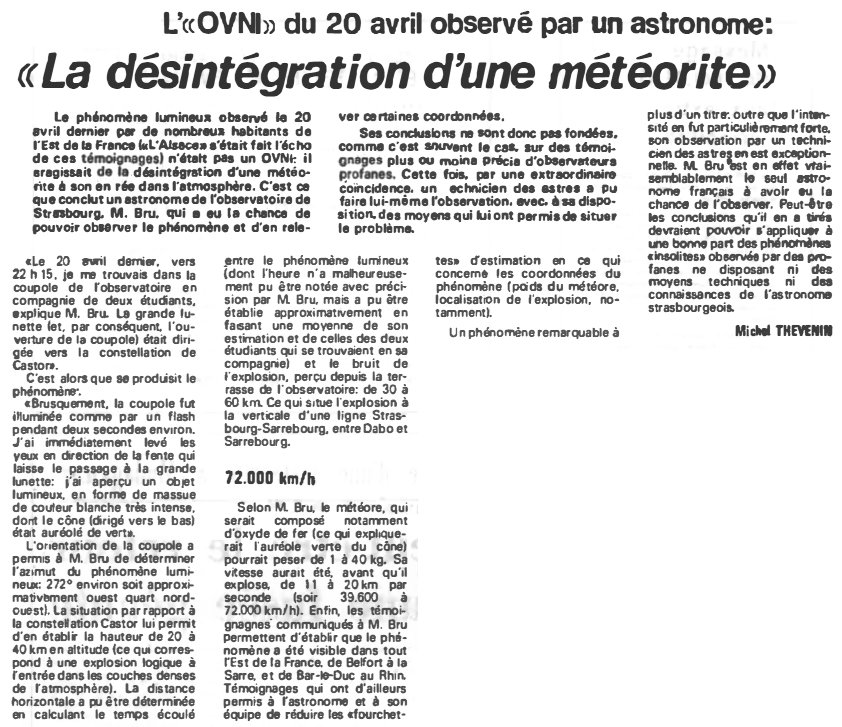
The article below was published in the daily newspaper L'Alsace, France, on May 16, 1977.
See the case file.

|
The luminous phenomenon observed on April 20 by many inhabitants of eastern France ("L'Alsace" echoed these testimonies) was not a UFO: it was the decay of a meteorite on its entry into the atmosphere. This is the conclusion of an astronomer from the Strasbourg observatory, Mr. Bru, who was lucky enough to be able to observe the phenomena and to note certain coordinates.
Its conclusions are therefore not based, as is often the case, on more or less precise testimonies from laymen observers. This time, by an extraordinary coincidence, a technician of the stars was able to make the observation himself, with, at his disposal, means which enabled him to locate the problem.
"On May 20, around 10:15 p.m., I was in the dome of the observatory with two students, explains Mr. Bru. The large telescope and, therefore, the opening of the dome was directed towards the Castor constellation."
That's when the phenomenon happened:
"Suddenly, the dome was illuminated as if by a lightning flash for about two seconds. I immediately looked up in the direction of the slit which leaves the passage to the large telescope, I saw a luminous object, in the shape of a club of very intense white color, the cone of which (directed downwards) was haloed in green."
The orientation of the dome allowed Mr. Bru to determine the azimuth of the luminous phenomenon: approximately 272° or approximately west quarter northwest). The situation in relation to the constellation Castor enabled him to establish its height from 20 to 40 kilometers in altitude (which corresponds to a logical explosion when entering the dense layers of the atmosphere). The horizontal distance could be determined by calculating the time elapsed between the luminous phenomena (the hour of which unfortunately could not be noted with precision by M. Bru [oh!], But could be established approximately by taking an average of his estimate and that of the two students who were in his company) and the sound of the explosion, perceived from the observation terrace: from 30 to 60 kilometers. This places the explosion directly above a Strasbourg Sarrebourg line, between Dabo and Sarrebourg.
According to Mr. Bru, the meteor, which would be composed in particular of iron oxide (which would explain the green halo of the cone) [no: copper] could weigh from 1 to 40 kg. Its speed would have been, before it exploded, from 11 to 20 km / s (that is to say 39,600 to 72,000 km / h. Finally, the testimonies communicated to Mr. Bruz make it possible to establish that the phenomenon was visible in all the East of France, from Belfort to the Saar [Germany], and from Bar-le-Duc to the Rhine. Testimonies which have also enabled the astronomer and his team to reduce the estimation "ranges" in this regard; which concerns the coordinates of the phenomenon (weight of the meteor, location of the explosion, in particular).
A remarkable phenomenon in more than one way: apart from its particularly strong intensity, its observation by a star technician is exceptional. Mr. Bru is indeed probably the only French astronomer to have had the chance to observe it. Perhaps the conclusions he drew from it should be able to apply to a good part of the "unusual" phenomena observed by laypersons who have neither the technical means [no technical means have been used here] nor the knowledge of the Strasbourg astronomer.
Michel THEVENIN